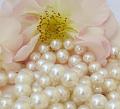Mikeyy
Pearl Diver
Being in the U.S. nuclei and mussel shell trade since 1969 I think I am qualified to point out some bad practices that have taken hold in recent years. In order to save a few bucks some farmers have taken to using inferior nuclei made from all sorts of odd shells. I have been approached by pearl dealers who have asked me why they have seen an increase in cracking and splitting pearls, in chipping around the drill holes. They want to know why their drill bits are getting so hot and going dull so quickly. Or why some pearls are just so damn hard to drill. Well, it's because some farmers in the misguided idea of saving a few dollars have been putting poor quality nuclei in their oysters like the Tridacna (giant clam) shell and the harder and more brittle Chinese freshwater shell varieties. Often these products are processed and bleached with chemicals to give them a better color. The farmers have a lower retention and quality rate and the end users have issues with drilling and for what? What a farmer gains from saving a few dollars on nuclei they lose in the back end. Some farmers in the south seas that I won’t name have come to this realization and have returned to using the U.S. nuclei. The same goes for Japan. I would suggest to those who believe that they are buying nuclei that they are being told is American shell nuclei ask their suppliers for proof of origin of their shells. They should have papers to show of where the shell comes from. It’s hard to ship a container from Los Angeles to Guangzhou without an invoice. If I am going to tend to an oyster for a year and a half I would sure like to know what I have put into that animal. The nuclei can look very similar but looks aren’t everything. I get ads sent to me from Alibaba with companies claiming American shell nuclei. They say that because they understand the value of saying so but I can almost guaranty you it’s not what they claim. I have been to these factories and they couldn't produce a American shell anytime I have been there. Yet they claimed thats what their product was made of. Just thought I’d share some advice.
Last edited:


